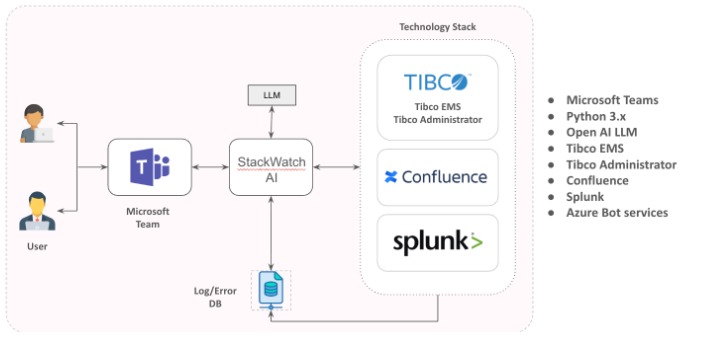In IT operations today, many hours are lost not in fixing problems—but in simply trying to understand what the problem actually is. Critical incidents often set off a chain reaction: conference calls begin, support groups light up on Teams, someone logs into TIBCO Administrator, another checks EMS queues, another sifts through Splunk logs. Yet after 15 minutes, three people, and five different systems, the answer is often still elusive: “Is the app even running?”
This is the heart of the challenge. Too much time gets lost in chasing information before resolution even begins. Every minute spent hunting for logs, dashboards, or process health is a minute that business systems remain down and customers are impacted.
This is exactly the problem that the iSteer StackWatch AI Agent is designed to solve.
At iSteer, we’ve spent years helping enterprises modernize their integration and support landscapes. StackWatch AI Agent is the next step in that journey — born from real-world problems in TIBCO ecosystems, designed hand-in-hand with support teams, and powered by AI to scale with your evolving needs.
Our vision is to turn every support desk into a smart desk — one where AI augments human expertise, so critical incidents are resolved faster, risks are detected earlier, and teams can operate with confidence.
The Challenge: Too Many Systems, Too Much Delay
Imagine this scenario:
A P1 ticket lands — a critical application is failing to transform messages to the CRM system. Within minutes, chat groups go live and multiple teams scramble to investigate.
Someone logs into TIBCO Administrator to check deployments.
Another digs into EMS queues using GEMS or CLI.
A different engineer fires up Splunk and runs raw log queries.
Meanwhile, messages fly across Teams channels: “Any update? Is the app even running?”
By the time an answer takes shape, it has consumed 15 minutes, 3 people, and 5 different systems. Multiply this across dozens of incidents, and the operational drag becomes enormous.
The question is simple: What if these answers were available instantly through a single conversational interface?
Meet StackWatch AI Agent: The Future of IT Ops Assistance
StackWatch AI Agent turns natural queries into instant, actionable insights. Instead of hunting across tools, your teams can simply ask:
“How many pending messages are in queue sample?”
“Show me last 10 errors for App X.”
“When was the last deployment for this app?”
The Agent securely connects to TIBCO EMS, TIBCO Administrator, Splunk, and Confluence, interprets the query using NLP, executes the right commands in real time, and responds back directly within familiar collaboration channels like Microsoft Teams.
StackWatch replaces complexity with clarity.
Key Capabilities of StackWatch AI Agent
1. TIBCO EMS Integration
From queue health checks to listener monitoring, StackWatch leverages NLP to instantly surface EMS insights. No need for CLI commands or GUI logins — your teams can:
Monitor pending message counts for queues and topics.
Retrieve queue listener counts.
Identify consuming applications.
Run real-time health checks by simply asking in plain English.
2. TIBCO Administrator Integration
Application availability directly impacts business outcomes. StackWatch transforms how ops teams track deployments and application health:
Get the deployment status of any app on demand.
Retrieve last deployment timestamps.
List active, swapped, or aborted processes.
Monitor overall app health and availability continuously.
3. Splunk & Log Analysis
Searching logs shouldn’t require coding expertise. With StackWatch, teams can type natural queries like:
The Agent automatically translates the request into a valid Splunk query, executes it, and returns results in real time. It even builds sample queries when needed, turning complex syntax into simple human understanding.
4. Confluence Knowledge Access
Support doesn’t stop with systems — knowledge and documentation are just as critical. StackWatch integrates with Confluence to:
Fetch application overviews and architecture diagrams.
Provide direct links to runbooks.
Identify owners and points of contact (POCs).
Streamline onboarding by surfacing dependencies and guides instantly.
StackWatch AI Agent Architecture

The diagram shows how Microsoft Teams connects through Azure Bot Services to power natural queries, which are interpreted by AI (LLM) and passed to backend systems like Tibco EMS, Tibco Administrator, Confluence, and Splunk. The seamless flow illustrates how StackWatch serves as a bridge between human queries and complex enterprise systems.
Capabilities in Action
Real-Time EMS Visibility
Support can instantly:
– Check pending message counts.
– Monitor queues and topics.
– Identify which apps are consuming queues.
Application Health Checks
Teams no longer guess about deployments or app status. They can:
– Retrieve health and availability instantly.
– Track lists of active, swapped, or aborted processes.
– Confirm when the last deployment occurred.
Automated Log Retrieval
Without learning Splunk syntax, users can type:
– “Errors from the last 30 minutes for BillingApp.”
– The agent automatically builds the query, executes it, and returns results.
Knowledge at Your Fingertips
Onboarding or escalation made easy with:
– Links to runbooks.
– Owner/POC information.
– Architecture overviews that normally take time to dig out of Confluence.
Business Benefits
Faster Incident Resolution: Eliminate delays caused by tool-hopping and cross-team dependencies. Teams get instant answers, reducing Mean Time to Resolution (MTTR).
Improved Productivity: Free support staff from repetitive queries. Let AI handle the basics so humans focus on complex troubleshooting.
Reduced Errors: Manual queries and lookups are prone to mistakes. StackWatch ensures precision every time with consistent, automated retrieval.
Knowledge Access Anywhere: New joiners and seasoned engineers alike can access documentation and process runs without sifting through multiple Confluence spaces.
Better Collaboration: Direct integration with Teams means everyone stays aligned, updated, and informed — without toggling screens.
Why iSteer StackWatch AI Agent
At iSteer, we design solutions with one guiding principle: make technology work for people, not the other way around.
With StackWatch:
AI reduces incident chaos to simple clarity.
IT and support teams get time back.
Organizations shorten MTTR, save costs, and improve customer satisfaction.
StackWatch is not just another monitoring interface — it’s an intelligent agent that always knows where to look and how to answer.
StackWatch AI Agent — Faster insight. Smarter support. Better business.








